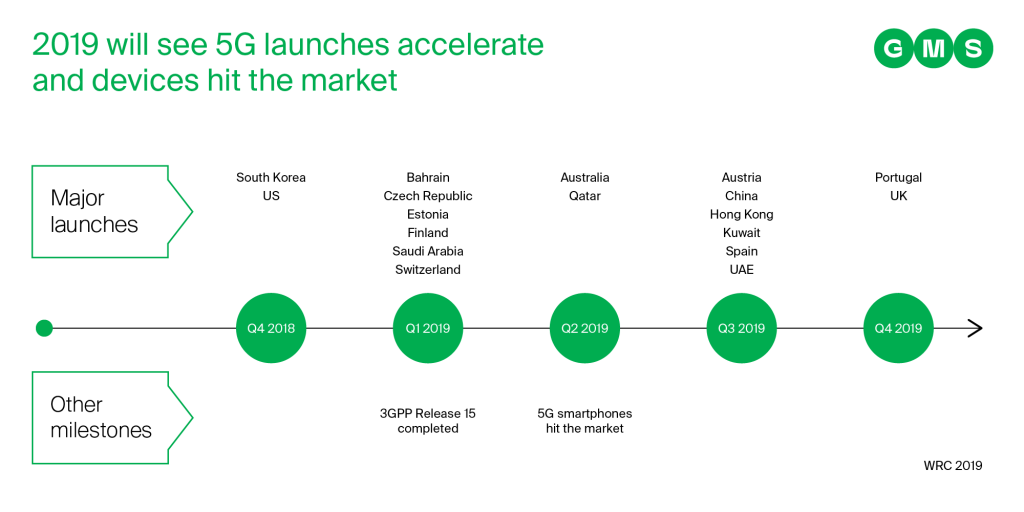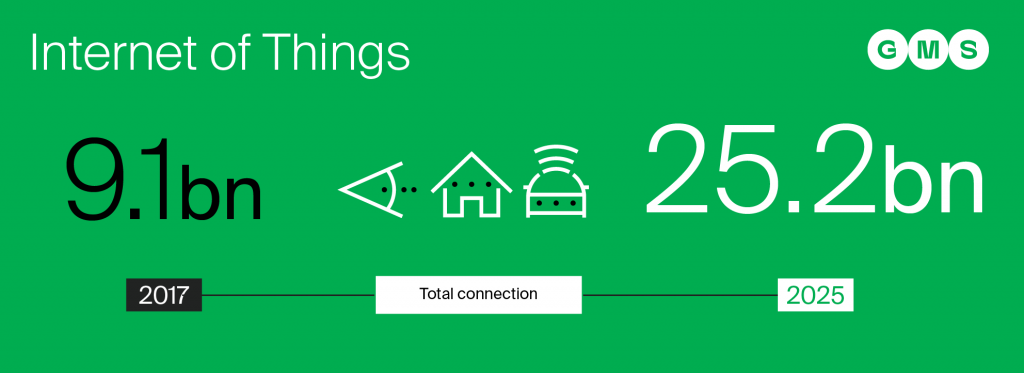Of all the new telecoms technologies currently emerging, 5G is probably the one most ordinary people know and talk about. New use cases and services are continually being revealed, with commentators making much of the futuristic potential of remote surgery and improvements to self-driving cars. With faster browsing and download speeds, consumers are also being promised much, which helps to keep the technology in the public eye. But how will it really impact them, and the marketers and enterprises trying to reach them?
What is 5G?
5G simply means “5th generation”, referring to the latest generation of mobile telecommunications technology. Usually this means a new protocol, and always a new frequency bandwidth via which data is transmitted. So, for example 2G enabled the development of SMS, while 3G introduced higher data rates, kickstarting “mobile broadband.”

5G is often spoken of in similar terms, as enabling greater speeds, leading to faster, high-quality downloads. However, what makes it truly revolutionary is the lower latency and greater number of connections it is capable of handling at the same time. Both of these have great potential for driving the internet of things (IoT), in which machines can communicate with one another, or with a home base, greatly aiding automation and remote management.
Marketing and advertising
But what of the everyday user? Whilst some oracles point to faster speeds leading to improved ad serving it is not certain that this will lead to more exposure, nor is there any guarantee that people will stop using ad blocking software. 5G speeds mean that pages load faster, true, but can mobile marketers really expect that this will mean an appreciable increase in content consumed, as some claim? We think it unlikely that more articles taking 5-10 minutes to read will be consumed simply because each loads a second or two faster. Furthermore, ads served at today’s speeds will still load by the time the user has finished reading an article or commenting on a social media page; and people do not use ad blockers solely because of speed.
However, speed does present a challenge given that pages will load much faster, if ad servers are not updated to match this pace and reduce latency, ads will only become more of a burden to loading times. A page could conceivably load faster, but because the advertising infrastructure used to deliver the ads on that page has not been brought up to 5G speeds it now creates a more perceptible delay. Users will likely have a much lower tolerance for delays caused by ads loading — and if mobile advertisers don’t bring their architecture up to speed there may be an increase in the use of ad blockers as consumers look to guarantee the speed they were promised.
Augmented realities
Another way that 5G will potentially affect customers is how it enables other technologies. Several sources think that improvements to data processing will make augmented reality (AR) a viable tool, with “hands-on” experiences and (shared) interactive experience becoming part of the mainstream. Done right, AR may become another integral part of multichannel marketing.
When it comes to how 5G will enable AR, these sources are a little vaguer. We think they are mainly referring to the increased speed and reduced latency, which will mean that AR constructs will be more responsive. When a user’s device registers the presence of an AR-enhanced surface or trigger, the experience will start near instantaneously and smoothly. When they interact with a virtual object, it will instantly react to their input. They also cite the increased number of connections 5G can handle — which will be critical for rolling out AR at scale.
However these commentators may also have in mind the improved location data available from 5G, which should allow smoother AR experiences with fewer or no trackable anchors to worry about. (Anchors are the points in the real world a camera can “see” that help it orient an AR image, sometimes physical object in the environment, sometimes placed markers like QR codes.)
This delivers a great deal of “cool factor” — people can try out a virtual object before buying the real thing, or get detailed information on a product — but the fact is that augmented reality requires the customer to actively initiate the experience. This is amazing for marketing, but it could be a problem for some use cases centered on advertising.
Unless they are using something like Google’s ill-fated Glass, or Microsoft’s enterprise-oriented Hololens, users will have to activate their phone (and probably an AR app) and point it at an advertisement. In other words, customers will have to actively choose to be sold to. Few people are likely to want to do this unless marketers and advertisers make their augmented realities novel and interactive enough to be noteworthy. Otherwise, people may not flock to yet another environment where they will be advertised at.
Improved interactive messaging
5G’s massive connectivity and reduced latency will also aid two other technologies: rich communication services (RCS) and chatbots. RCS works over an IP data connection, so the ability to handle more connections will keep the delivery of this next generation of messaging quick and responsive. We’ve talked a lot about RCS in the past — it’s a big deal in some messaging circles — so here we’ll just point out this is something marketers will definitely want to keep an eye on.
The same will be true for chatbots (delivered over OTT messaging apps like Viber or WhatsApp, or over RCS itself). The ability to engage in automated two-way text messaging will open brands up to their customers in new, exciting ways. It’s not just about opportunities for truly interactive marketing. Customer service queries and product enquiries will be easier to access and more effective. As consultancy company Forrester points out, chatbots won’t replace human agents: they will make them more effective, by handling routine requests and letting the humans devote more time to more complex requests where excellent customer service is paramount.
Like RCS and ad serving, chatbots will greatly benefit from reduced latency, since they will be able to respond more quickly and seamlessly to customer queries. Such responsiveness is crucial to enhancing the overall experience and further creating the feeling of a true conversation. But that low latency is actually one component of something that makes 5G really attractive to operators — the ability to enable edge computing. This is a huge benefit to IoT, but not necessarily to marketers.
5G is not yet a mature technology
Whilst marketing gurus are breathless over the possibilities of 5G and the impact it will have on consumers, the truth is that 5G is not a consumer-oriented standard. Intentionally or otherwise, 5G’s main strength is how it facilitates the Internet of Things.

Flexible, low-latency communications, with lower power consumption and better location data, mean that the most revolutionary benefits of the technology actually go to enterprise sectors, not consumers who, at least to begin with, will really only be aware of an increase in speed.
Operators also have to make 5G pay, but it is unlikely that customers will pay a premium for it — meaning the real money, and incentive to invest in 5G infrastructure, will only come with widespread IoT adoption. New, revolutionary and international IoT use cases, on the other hand, will depend on robust 5G coverage. Until this circular dependency is sorted out, 5G is unlikely to be available to most consumers.
At Global Message Services, we think 5G will create new ways to drive brand engagement, but brands, enterprises, and those who represent them should be aware of the challenges. Augmented reality in particular will require a new approach to marketing collaterals and content.
Marketers need to be aware of where their MNO partners are in terms of 5G rollout, as well as their own technological infrastructure and business case. They need to be realistic about the available audience and think before rolling out massive new architectures or flashy AR billboards. A clear, realistic 5G strategy will be crucial to making the most out of this exciting new technology.
Find out how GMS Enterprise messaging services can help marketers better engage your customers today.

